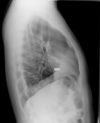Surgical removal of a bullet in the heart through a trans-mitral approach: a case report
- PMID: 36466130
- PMCID: PMC9709558
- DOI: 10.1093/ehjcr/ytac413
Surgical removal of a bullet in the heart through a trans-mitral approach: a case report
Abstract
Background: Retained cardiac missiles have been considered bullets, shrapnel, or pellets included in the heart or the pericardial sac. In asymptomatic patients with retained cardiac missiles, the role of surgery is still debated.
Case summary: We describe the case of successful surgical treatment of a retained missile localized within the left ventricle in close proximity of the posterior mitral leaflet. The operation was performed through a transatrial approach, detaching the posterior mitral leaflet. The post-operative course was uneventful. The patient was discharged on the seventh post-operative day. At 30-day follow-up visit, the patient was in good conditions, with normal mitral valve function.
Discussion: The management of retained cardiac missiles should be individualized. If a decision is made to operate, multiple imaging techniques including echocardiography and computed tomography scan are mandatory to precisely locate the bullet.
Keywords: Cardiac surgery; Case report; Mitral valve; Retained cardiac missiles.
© The Author(s) 2022. Published by Oxford University Press on behalf of the European Society of Cardiology.
Conflict of interest statement
Conflict of interest: None declared.
Figures




References
-
- Lundy JB, Johnson EK, Seery JM, Pham T, Frizzi JD, Chasen AB. Conservative management of retained cardiac missiles: case report and literature review. J Surg Educ 2009;66:228–235. - PubMed
-
- Klein JA, Nowak JE, Sutherell JS, Wheeler DS. Nonsurgical management of cardiac missiles. Pediatr Emerg Care 2010;26:36–38. - PubMed
-
- Fyfe DA, Edgerton JR, Chaikhouni A, Kline CH. Preoperative localization of an intracardiac foreign body by two-dimensional echocardiography. Am Heart J 1987;113:210–212. - PubMed
Publication types
LinkOut - more resources
Full Text Sources
